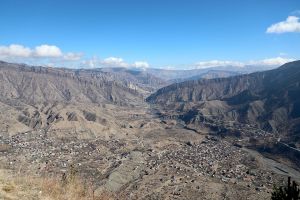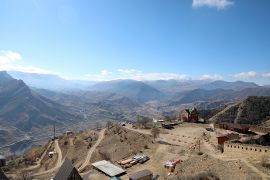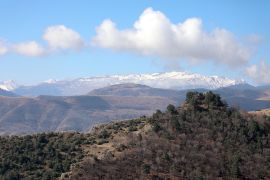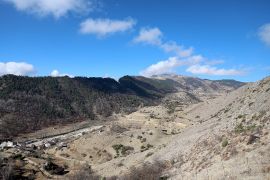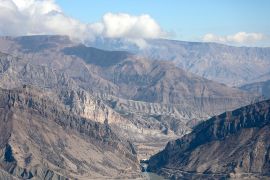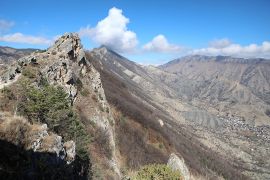Gunib plateau
46.962173E
The Gunib Plateau is located in the Republic of Dagestan, Russian Federation. It is situated between two rivers - Avarskoye Koysu and Karakoysoo. The plateau is named after the nearby settlement of Gunib.
Geography of the plateau
The average elevation of the plateau is 1,700 meters, with its highest point reaching 2,352 meters at Mount Gunib (or Mayak). The plateau is surrounded by sheer limestone cliffs, which make it a natural fortress. In the valley of the plateau, there are many springs, small forests, and waterfalls. From the plateau, one can see many mountain peaks of Dagestan and the Main Ridge.
Sightseeing route
This place is famous for several attractions that are worth visiting:
- Gunib Fortress
- Gunib Museum
- Gunib Lighthouse
Gunib Fortress
The Gunib Fortress, built between 1863 and 1867, is a historical monument and architectural heritage of the region. It served as a defensive stronghold during the Russo-Caucasian War under the leadership of Imam Shamil. The fortress had significant strategic importance as it guarded the western side of the Gunib Plateau, providing natural protection with its sheer walls.
Today, the complex consists of partially ruined fortress walls and towers. The remaining section of the wall is about 3 kilometers long and has a height ranging from 1 to 3 meters.
Along the surviving wall, one can climb up to a platform, offering a picturesque view of the Gunib Plateau valley.
- Photos of the fortress
-
The surviving part of the fortress wall
-
Landscape on the plateau from the side of the fortress
Gunib Museum
The Gunib Regional Museum, located in the building of the historical Gunib Garrison Church, offers an interesting journey into the past. It opened its doors in 2001 and is a branch of the A. Taho-Godi National Museum of Dagestan.
One of the main sections of the museum, known as the "Mountain Dwellers' Hut," recreates the atmosphere of mountain dwellers' life through a two-story space designed in the archaic mountain architecture style. Visitors can see antique carved furniture, a collection of copperware, various types of ceramics, handicraft tools, agricultural implements, carpets, as well as traditional costumes.
In addition, the museum showcases items from the palace built for Pavel Romanov, the son of Emperor Alexander II. The palace, recommended by Pirogov, was constructed with two-meter-thick walls, and in 1867, its entire interior, including furniture, tableware, carriages, and staff, was transported from St. Petersburg to Gunib. The museum preserves a large oak table and two mirrors from this palace interior.
Furthermore, the museum offers interesting sections dedicated to paleontology and archaeology. The museum's overall collection consists of over 1,660 exhibits that attract visitors' attention.
Gunib Lighthouse
Gunib Lighthouse is a mountain peak that is the highest point of the Gunib Plateau, reaching a height of 2,350 meters. Climbing to this summit provides a breathtaking view of the snow-covered peaks of the Main Caucasus Range and the entire Inner Dagestan region. One can also see the Bogos Ridge, known for its inaccessible and little-explored areas, as well as the highest peak - Mount Kad, standing at a height of 4,111 meters.
Photo Gallery
- Photos of the Gunib Plateau
-
Landscape of the valley of the Gunib plateau
-
Dagestan Range
-
The highest point is Mount Mayak
-
Mountains around the Gunib plateau
-
Panoramic view of the plateau


